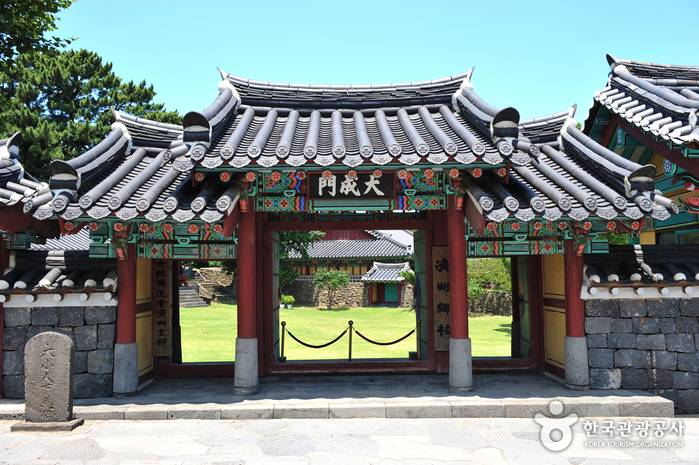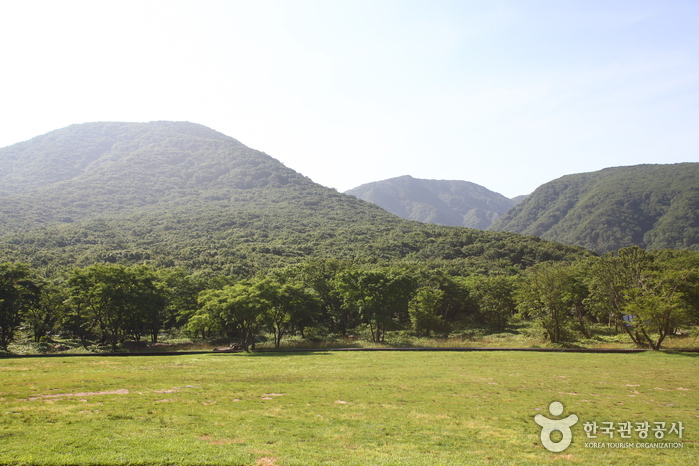Jejuhyanggyo Confucian School (제주향교)
8.8 Km 11293 2020-02-18
43, Seomun-ro, Jeju-si, Jeju-do
+82-64-757-0976
Jejuhyanggyo Confucian School is an educational center that teaches Confucianism to local people, and holds ancestral ceremonies for the great Confucian scholars. It is also used as an administration office, and a gathering place for the local Confucians. It has two main halls: Myeongnyundang and Daeseongjeon, which houses ancestral tablets.
Yongduam Rock (용두암)
8.9 Km 171273 2023-01-13
Yongduam-gil, Jeju-si, Jeju-do
+82-64-740-6000
Situated on the northern coast in downtown Jeju, Yongduam Rock is an estimated 10-meter-tall stone that has been worn down over time by strong winds and waves into a shape resembling a dragon's head. There are many legends surrounding the rock. One legend has it that a dragon stealing precious jade from Hallasan Mountain was shot down by an arrow from the mountain deity. When he fell down, his body immediately sank into the ocean and his head rapidly froze looking at the sky. Another legend has it that a white horse, who dreamed of being a dragon and ascending to the sky, came to be caught by a soldier and froze into the rock.
From Yongduam Rock, visitors can see haenyeo (female divers) working at catching seafood. Near the rock are various cafes, bars, and restaurants. The coastal road between here and Aewol-eup is popular among couples. Cafes and seafood restaurants began to appear there five years ago and now form a pleasant café village.
Jeju Olle Trail - Route 16 (Gonae - Gwangnyeong Olle) ([제주올레 16코스] 고내-광령 올레)
9.0 Km 6040 2021-06-14
1111-2, Gonae-ri, Jeju-si, Jeju-do
+82-64-762-2190
Route 16 connects the beautiful coastal walk to mid-mountainous area. The trail goes from Gonae to Guam, where visitors can enjoy indigo-colored sea, saltern, reservoir, tall trees, old fortress, villages, and more.
Jeju Pacific Hotel (제주 퍼시픽 호텔)
9.0 Km 16849 2021-03-12
20, Seosa-ro, Jeju-si, Jeju-do
+82-64-758-2500
Jeju Pacific Hotel is located at the center of old Jeju where traditions and history of Jeju Island are well preserved. The hotel is a short distance from Jeju International Airport, making it easily accessible, as well as many popular tourist attractions such as Yongduam Rock and Dongmun Traditional Market.
BAGDAD (바그다드)
9.0 Km 12594 2021-03-19
38, Seogwang-ro, 32-gil, Jeju-si, Jeju-do
+82-64-757-8182
Bagdad is an Indian restaurant located near Jeju City Hall in Ido 2-dong, Jeju-si. Its chef, who is from India, offers high-quality traditional Indian dishes that draw hungry diners from all across the island. Some of the most popular dishes are chicken makhani (made with fresh tomatoes, cream and cheese), tandoori chicken, and nan (traditional Indian bread). For a winning taste combination, try one of the curries with a side of nan.
LG Best Shop - Samdo Branch [Tax Refund Shop] (엘지베스트샵 삼도점)
9.0 Km 0 2024-04-19
29, Seosa-ro, Jeju-si, Jeju-do
-
Olive Young - Jeju Araildong Branch [Tax Refund Shop] (올리브영 제주아라일동점)
9.1 Km 0 2024-06-27
527, Yeonbuk-ro, Jeju-si, Jeju-do
-
Hallasan Mountain [National Geopark] (한라산 (제주도 국가지질공원))
9.1 Km 435162 2022-11-30
2070-61, 1100-ro, Jeju-si, Jeju-do
+82-64-710-3945
Hallasan Mountain stands proudly at the center of Jeju Island and is perhaps the island’s most memorable landmark. Also called Yeongjusan Mountain, meaning "mountain high enough to pull the galaxy," Hallasan Mountain is widely known by scientists for its geological value. Designated as a national park in 1970, there are 368 parasitic cones called "oreum" (Jeju dialect meaning peak) around the main mountain.
Hallasan Mountain is famous for its vertical ecosystem of plants that results from the varying temperatures along the mountainside. Over 1,800 kinds of plants and 4,000 species of animals (3,300 species of insects) have been identified; to explore the mountain's treasures, simply follow one of the well-developed hiking trails.
Hallasan Mountain Trekking (한라산 트레킹)
9.1 Km 111319 2020-06-25
2070-61, 1100-ro, Jeju-si, Jeju-do
+82-64-740-6000
Situated on the southern tip of the Korean Peninsula, Hallasan is 1,950 meters in x_height and is the highest mountain in South Korea. Formed from volcanic activity, the mountain is a dormant volcano made mostly of basalt. Home to the magnificent Baekrokdam (lake-filled crater), the mountainside is covered with alpine flora and lush trees.
The mountain is characterized by majestic cliffs, steep slopes, interesting rock formations, and, in particular, myriads of colorful azaleas. There are over 360 small mountains (uniquely-shaped volcanic mountains called “Oreum” in Jeju dialect) surrounding Halla Mountain that offer new delights to visitors with the coming of each new season. Along with Hallasan, the oreums were officially named the Hallasan Natural Protection Area (Natural Monument No.12) in 1966.
There are six hiking trails along Hallasan. Seongpanak Trail on the east and Gwaneumsa Trail in the north go all the way up to the summit (Baekrokdam). Those looking for a less rigorous hike are advised to take the shorter trails reaching midway up the mountain. All trails are relatively short (less than 10 kilometers) and can be hiked in less than a day. Visitors are advised, however, to start early in the morning if planning on hiking up to the summit and to check official operating hours, as some trails are only open during certain hours of the day. Keep reading for information on some of the most popular trails.
* Gwaneumsa Trail (North)—Summit Trail
Gwaneumsa Trail offers hikers the best view of Hallasan’s deep valleys and stunning terrain. Midway along the trail is Guringul (a lava cave) and Tamna Valley. Tamna Valley is especially beautiful during the fall when the leaves are changing and during the winter when the entire area lays under a dusting of snow.
* Seongpanak Trail (East)—Summit Trail
This relatively long, gently sloping trail is perfect for beginners. Lush broadleaf trees give shade from the beating sun and in spring the azaleas bloom and turn the mountainside into a dazzling array of color.
* Eorimok Trail (Northwest)
This short trail is another relatively easy trail for beginners. In spring, the nearby meadows are adorned with red royal azaleas. From the stone pathway to Mansedongsan visitors can catch a breathtaking panoramic view of the countryside and the island’s signature Oreums.
* Yeongsil Trail (Southwest)
As the shortest trail in Hallasan, this trail boasts Yeongsilgiam (a spectacular cliff with series of unusual rock formations). It is covered with azaleas and royal azaleas in spring and vibrant autumn foliage starting in October.


![LG Best Shop - Samdo Branch [Tax Refund Shop] (엘지베스트샵 삼도점)](http://tong.visitkorea.or.kr/cms/resource/74/2887374_image2_1.jpg)
![Prepare [Tax Refund Shop] (프리페어)](http://tong.visitkorea.or.kr/cms/resource/86/3313386_image2_1.jpg)

 English
English
 한국어
한국어 日本語
日本語 中文(简体)
中文(简体) Deutsch
Deutsch Français
Français Español
Español Русский
Русский